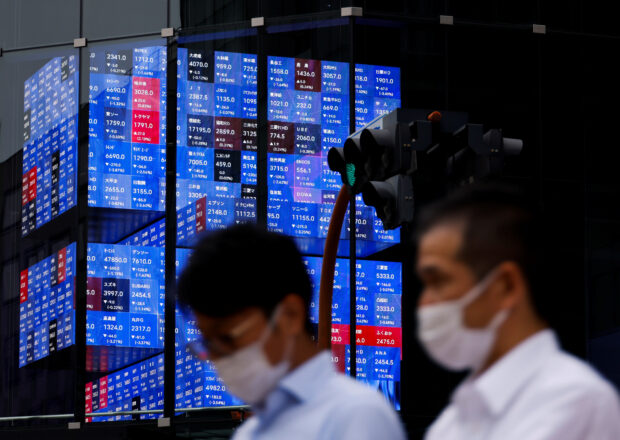
People pass by an electronic screen showing Japan’s Nikkei share price index inside a conference hall in Tokyo, Japan June 14, 2022. REUTERS/Issei Kato
TOKYO – A tailwind behind Japanese stocks is strengthening as large foreign funds who have been avoiding the market for decades start to reach into pockets deep enough to take the Nikkei back to its 1989 peak.
Their money was on the sidelines while the Nikkei 225 surged 27 percent in the first half of the year, as managers kept habitual below-benchmark weightings on Japan – settings that didn’t budge for years while the share index disappointed.
The best first-half gains in a decade, corporate reforms and continuing ultra-easy monetary policy supporting the economic recovery have led to a change in mindset.
The research arm of BlackRock, the world’s biggest asset manager, shifted its view on Japanese equities to neutral from underweight.
“We are looking for more evidence of corporate reform to support the enthusiasm for its equity markets that has gripped foreign investors so far this year,” wrote analysts at BlackRock Investment Institute, in its mid-year outlook report last week.
BlackRock’s shift could be the next step in the Nikkei story and open the floodgates for other deep-pocketed investors to join in the momentum.
Nomura Securities expects others will soon follow suit. Japan’s biggest brokerage estimates some 10 trillion yen ($70 billion) of potential inflows from foreign long-only investors as they rebalance portfolios in a mass migration to neutral weightings.
That amount would be enough to lift the Nikkei 5,000 points, Nomura said. It would take the index, which closed on Wednesday at 33,338.70 points, within striking distance of the 1989 peak of 38,957.44 during Japan’s bubble era when asset prices were greatly inflated.
Nikkei leads Asia higher, China struggles to keep up
“It’s not the case that we’ve already seen the completion of offshore investors’ quite aggressive investment in Japan equity markets,” said Nomura’s chief equity strategist for Japan, Yunosuke Ikeda.
“Although we see some temporary unwinding, inflows will continue.”
Chinese money pours into Japan-focused funds, triggering risk warnings
To the moon
“I don’t think the Nikkei will come back to the old range between 25,000-30,000,” said a Japanese pension fund manager who requested anonymity as he is not authorized to speak to media.
The fund manager said 39,000 “is not just a dream. It’s achievable. It’s not a moon shot.”
Archie Ciganer, a portfolio manager at T. Rowe Price, said his firm has been fielding inquiries about Japan investment from clients or regions that never inquired about Japan in the past.
“A lot of sticky money is moving into Japan,” he said. “It’s a lot of people who always used to have an underweight,” with the poor performance and negative sentiment surrounding China’s markets this year prompting global investors to look elsewhere.
“Japan has been attractive for quite some time, but you always had other markets that were more attractive or equally attractive, and China was one of them,” Ciganer said.
“Now, a lot of asset owners have decided just not to invest in China any more, and that’s made Japan the top dog in Asia.”
Buffett’s Berkshire boosts stakes in Japan’s five biggest trading houses
Although billionaire investor Warren Buffett has grabbed headlines with his Japan stock purchases, a lot of inflows have been from so-called fast money overseas, such as algorithmic traders or hedge funds investing with borrowed money.
The Nikkei soared as high as 33,772.89 on June 19, its highest point in 33 years, but faced a sharp pullback toward the end of the month as short-term investors booked profits.
Nikkei closes above 33,000 for the first time in 33 years
Overseas investors had been net buyers of Japanese stocks every week since the end of March, snapping up a cumulative 9.9 trillion yen in equities, but for the week through June 24 sold a net 543.8 billion yen, data showed.
Many analysts and investors, though, consider the declines a healthy and necessary retracement before the next leg higher, with 35,000 often touted as a target for this year as slower-moving foreign investors start to buy in size.
“The change under way is apparent,” said Vikas Pershad, portfolio manager for Asian equities at M&G Investments.
“We’re in the early stages of a long-term move higher in Japan’s equity market. There will be new peaks ahead.”
($1 = 144.6200 yen)